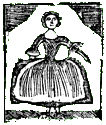That WorldCat page speculates about those initials:
Possibly by Hannah Wheaton, the author of several poems published during the 1790s. However, there are an insufficient number of dashes to match the name Wheaton and it is not known whether Wheaton was her maiden or a married name.Hannah Wheaton’s name is preserved on a handful of broadside verses. The earliest one with a date is from December 1793 and starts:
A New Year’s wish.That suggests Wheaton had issued a similar verse at the end of 1791 and perhaps earlier, but couldn’t do so in 1792. That surviving “New Year’s wish” mentions the death of John Hancock, meaning it was designed for a Massachusetts audience. It’s quite similar to the sheets that newspapers’ delivery boys printed and sold at the end of each year, suggesting that Hannah Wheaton was fitting herself into that tradition.
The author being absent by reason of the small-pox, prevented her addressing her friends the last year.
In 1795 Wheaton published “An independent ode, dedicated to the illustrious president of the United States [George Washington], the governour of this commonwealth [Samuel Adams], and all true patriots of liberty.” She issued elegies after the deaths of Ephraim May (a Boston businessman and father-in-law of the luckless schemer Dr. Amos Windship) in 1797 and of Washington in 1799.
A 1799 broadside from Wheaton is titled “On Taking an Affectionate Farewell of My Kind Benefactors in Boston.” I haven’t been able to find the text for that. Its library record suggests it’s about death, making me wonder whether she was announcing that she was mortally ill. Was she publishing a poetic eulogy for herself?
However, Brown University has a Hannah Wheaton broadside titled “For the commencement of a new century,” dated 1801. So she lived to keep writing and selling her verses.
Nobody has spotted a definite link between Wheaton and the print shop of Ezekiel Russell, known for issuing the same type of poetic broadside at any opportunity. Perhaps a close reading of the verses Wheaton signed would reveal similarities to the unsigned verses that came from the Russell shop near the Liberty Pole (and the 1787 broadside newly discovered to have been credited to “Miss H---. W---.”).
But that analysis would require someone with a stronger stomach for eighteenth-century doggerel.

No comments:
Post a Comment